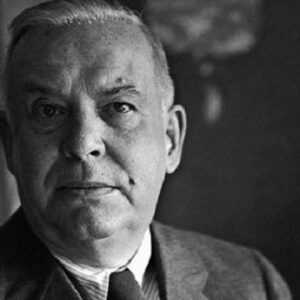In the 20th century, Wallace Stevens was regarded as one of the most influential American Modernist poets. Born in Reading, Pennsylvania, he attended Harvard and then New York Law School for his schooling. In addition to his passion for poetry, he spent a significant portion of his life as an attorney for the Hartford Insurance Company in Connecticut. Stevens largely neglected the literary world, and his “Collected Poems” did not gain widespread recognition and acclaim until their publication. Stevens explored a serious philosophical framework in this work. “Anecdote of the Jar,” “Disillusionment of Ten O’Clock,” “The Emperor of Ice-Cream,” “The Idea of Order at Key West,” “Sunday Morning,” and “Thirteen Ways of Looking at a Blackbird” are among the the his most famous and well-known poems. These poems were published collectively in “Collected Poems.” In 1955, he was awarded the coveted Pulitzer Prize for Poetry.
Stevens’ Youth, Early Life, and Profession
Wallace Stevens was born in Reading, Pennsylvania on October 2, 1879. His father was a successful attorney. He enrolled as a non-degree special student at Harvard. Following this, Stevens relocated to New York City and worked as a journalist for a little period. Subsequently, he attended New York Law School and graduated in 1903.
When Stevens returned to Reading in 1904, he met Elsie Viola Kachel, the woman who would later become his wife. In 1913, he rented a New York City apartment from sculptor Adolph A. Weinman. Stevens worked for a number of New York law firms between 1904 and 1907 before being appointed as an attorney for the American Bonding Company on 13 January 1908.
By 1914, Stevens was vice-president of the Equitable Surety Company of St. Louis, Missouri’s New York office. However, due to mergers in 1916, this position was eliminated. He then traveled to Hartford and joined the home office of Hartford Accident and Indemnity Company.
In 1934, Stevens became the vice president of this corporation. After receiving the Pulitzer Prize in 1955, Stevens was invited to teach at Harvard, but he declined because he did not wish to leave his position as vice president of The Hartford.
From 1922 to 1940, Stevens made numerous trips to Key West, Florida, and stayed at the Casa Marina, an Atlantic Ocean hotel. The place had a significant impact on Stevens’ poetry, which is evident in his numerous works, particularly those released in his early collections such as “Harmonium” and “Ideas of Order.”
In February 1935, he met another great poet, Robert Frost, in the same hotel. The meeting was not productive, as they both argued. Frost later alleged that Stevens was intoxicated and acting aggressively. Stevens allegedly assaulted Ernest Hemingway in 1936 during a party at the Waddell Avenue residence.
Stevens reportedly shattered his hand while attempting to strike Hemingway in the jaw when he was knocked to the ground by Hemingway. He apologized subsequently for his inappropriate behavior. 1940 was Stevens’ last visit to Key West.
During the 1930s and 1940s, Stevens was asked to join the circle of creative and literary enthusiasts centered on Barbara and Henry Church. Steven remained politically conservative throughout his life.
Wallace Stevens’s Poetry
Stevens wrote his first significant work at the age of 35. It is a collection of four poems from a sequence titled “Phases” that appeared in the November 1914 issue of Poetry Magazine. The majority of his well-known compositions were composed well after the age of fifty.
In 1923, his first collection of poetry, “Harmonium,” a volume of rococo ingenuity, was published. During the 1920s and 1930s, he authored two further notable works. In the 1940s, he published three more poetry collections. He received the National Book Award in both 1951 and 1955.
The majority of his writings were introspective and philosophical. Stevens’ imagination in his poems was not equivalent to consciousness, nor was it a reality to the universe that exists outside of people’s minds. This notion can be found in “The Idea of Order at Key West” and “Opus Posthumus” by Stevens. Even from his earliest efforts, critics began admiring his work. His popularity increased significantly after his passing.
The Blue Guitar: Etchings By David Hockney Who Was Inspired By Wallace Stevens Who Was Inspired by Pablo Picasso was published by David Hockney in 1977. This book contains Stevens’s poems. Petersburg Press published the piece as a portfolio and a book in 1997.
Wallace’s Personal Life
Stevens married Elsie Viola Kachel in 1909 over his parents’ vehement objections, since they viewed her as a low-class woman. Holly, the couple’s daughter, was born in 1924. In later years, Elsie Stevens began exhibiting indications of mental illness, which caused their marriage to falter, although they never divorced.
Wallace Steves’s Death
In April 1955, it is thought that Fr. Arthur Hanley, chaplain of St. Francis Hospital in Hartford, Connecticut, baptized Stevens as a Catholic. There, Stevens passed away after contracting stomach cancer in his final days. Immediately after being released from the hospital, he was readmitted. Stevens died on August 2, 1955, aged 75. He was at the Cedar Hill Cemetery in Hartford.
Wallace Stevens’s Poetry
Snowman’s Harmonium
Thoughts about Order Owl’s Clover
The Man with the Blue Guitar Transports the World to Summer
The Auroras of Autumn: A Compilation of Poems The Necessary Angel in Poetry Posthumous archives
Obituary Work
The Brain’s Final Palm
Selected Poems from Collected Poetry and Prose
Estimated Net Worth
Wallace is one of the wealthiest and most popular poets. According to our investigation, Wikipedia, Forbes, and Business Insider, Wallace Stevens has an estimated net worth of $1.5 million.


